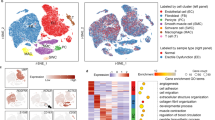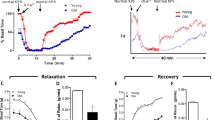Abstract
The MaxiK channel plays a critical role in the regulation of corporal smooth muscle tone and thereby erectile function. Given that ageing results in a decline in erectile function, we determined changes in the expression of MaxiK, which might impact erectile function. Quantitative-polymerase chain reaction demonstrated that although there is no significant change in transcription of the α- and β-subunits that comprise the MaxiK channel, there are significant changes in the expression of transcripts encoding different splice variants. One transcript, SV1, is 13-fold increased in expression in the ageing rat corpora. SV1 has previously been reported to trap other isoforms of the MaxiK channel in the cytoplasm. Correlating with increased expression of SV1, we observed in older rats there is approximately a 13-fold decrease in MaxiK protein in the corpora cell membrane and a greater proportion is retained in the cytoplasm (approximately threefold). These experiments demonstrate that ageing of the corpora is accompanied by changes in alternative splicing and cellular localization of the MaxiK channel.
This is a preview of subscription content, access via your institution
Access options
Subscribe to this journal
Receive 8 print issues and online access
$259.00 per year
only $32.38 per issue
Buy this article
- Purchase on Springer Link
- Instant access to full article PDF
Prices may be subject to local taxes which are calculated during checkout



Similar content being viewed by others
References
Andersson KE . Erectile physiological and pathophysiological pathways involved in erectile dysfunction. J Urol 2003; 170: S6–S13.
Shabsigh R, Perelman MA, Lockhart DC, Lue TF, Broderick GA . Health issues of men: prevalence and correlates of erectile dysfunction. J Urol 2005; 174: 662–667.
Hirano K, Hirano M, Kanaide H . Regulation of myosin phosphorylation and myofilament Ca2+ sensitivity in vascular smooth muscle. J Smooth Muscle Res 2004; 40: 219–236.
Leblanc N, Ledoux J, Saleh S, Sanguinetti A, Angermann J, O'Driscoll K et al. Regulation of calcium-activated chloride channels in smooth muscle cells: a complex picture is emerging. Can J Physiol Pharmacol 2005; 83: 541–556.
Archer SL . Potassium channels and erectile dysfunction. Vasc Pharmacol 2002; 38: 61–71.
Werner ME, Zvara P, Meredith AL, Aldrich RW, Nelson MT . Erectile dysfunction in mice lacking the large-conductance calcium-activated potassium (BK) channel. J Physiol 2005; 567: 545–556.
Melman A, Zhao W, Davies KP, Bakal R, Christ GJ . The successful long-term treatment of age related erectile dysfunction with hSlo cDNA in rats in vivo. J Urol 2003; 170: 285–290.
Christ GJ, Rehman J, Day N, Salkoff L, Valcic M, Melman A et al. Intracorporal injection of hSlo cDNA in rats produces physiologically relevant alterations in penile function. Am J Physiol 1998; 275: H600–H608.
Christ GJ, Day N, Santizo C, Sato Y, Zhao W, Sclafani T et al. Intracorporal injection of hSlo cDNA restores erectile capacity in STZ-diabetic F-344 rats in vivo. Am J Physiol Heart Circ Physiol 2004; 287: H1544–H1553.
Melman A, Bar-Chama N, McCullough A, Davies K, Christ G . The first human trial for gene transfer therapy for the treatment of erectile dysfunction: preliminary results. Eur Urol 2005; 48: 314–318.
Melman A . Gene transfer for the therapy of erectile dysfunction: progress in the 21st century. Int J Impot Res 2006; 18: 19–25.
Melman A, Bar-Chama N, McCullough A, Davies K, Christ G . hMaxi-K gene transfer in males with erectile dysfunction: results of the first human trial. Hum Gene Ther 2006; 18: 1165–1176.
Schiff JD, Melman A . Ion channel gene therapy for smooth muscle disorders: relaxing smooth muscles to treat erectile dysfunction. Assay Drug Dev Technol 2006; 4: 89–95.
Gribkoff VK, Starrett Jr JE . Dworetzky SI.Maxi-K potassium channels: form, function, and modulation of a class of endogenous regulators of intracellular calcium. Neuroscientist 2001; 7: 166–177.
Tanaka Y, Koike K, Alioua A, Shigenobu K, Stefani E, Toro L . Beta1-subunit of maxiK channel in smooth muscle: a key molecule which tunes muscle mechanical activity. J Pharmacol Sci 2004; 94: 339–347.
Patterson AJ, Henrie-Olson J, Brenner R . Vasoregulation at the molecular level: a role for the beta1 subunit of the calcium-activated potassium (BK) channel. Trends Cardiovasc Med 2002; 12: 78–82.
Orio P, Rojas P, Ferreira G, Latorre R . New disguises for an old channel: MaxiK channel beta-subunits. News Physiol Sci 2002; 17: 156–161.
Fury M, Marx SO, Marks AR . Molecular bkology: the study of splicing and dicing. Sci STKE 2002; 2002: PE12.
Zarei MM, Zhu N, Alioua A, Eghbali M, Stefani E, Toro L . A novel maxiK splice variant exhibits dominant-negative properties for surface expression. J Biol Chem 2001; 276: 16232–16239.
Zarei MM, Eghbali M, Alioua A, Song M, Knaus HG, Stefani E et al. An endoplasmic reticulum trafficking signal prevents surface expression of a voltage- and Ca2+-activated K+ channel splice variant. Proc Natl Acad Sci USA 2004; 101: 10072–10077.
Calabro A, Italiano G, Pescatori ES, Marin A, Gaetano O, Abatangelo G et al. Physiological aging and penile erectile function: a study in the rat. Eur Urol 1996; 29: 240–244.
Tong Y, Tar M, Davelman F, Christ G, Melman A, Davies KP . Variable coding sequence protein a1 as a marker for erectile dysfunction. BJU Int 2006; 98: 396–401.
Rajasekaran M, White S, Baquir A, Wilkes N . Rho-kinase inhibition improves erectile function in aging male Brown–Norway rats. J Androl 2005; 26: 182–188.
Nishimaru K, Eghbali M, Stefani E, Toro L . Function and clustered expression of maxiK channels in cerebral myocytes remain intact with aging. Exp Gerontol 2004; 39: 831–839.
Xie J, McCobb DP . Control of alternative splicing of potassium channels by stress hormones. Science 1998; 280: 443–446.
Korovkina VP, Fergus DJ, Holdiman AJ, England SK . Characterization of a novel 132-bp exon of the human maxi-K channel. Am J Physiol Cell Physiol 2001; 281: C361–C367.
Kwon SH, Guggino WB . Multiple sequences in the c terminus of maxiK channels are involved in expression, movement to the cell surface, and apical localization. Proc Natl Acad Sci USA 2004; 101: 15237–15242.
Nishimaru K, Eghbali M, Lu R, Marijic J, Stefani E, Toro L . Functional and molecular evidence of maxiK channel beta1 subunit decrease with coronary artery ageing in the rat. J Physiol 2004; 559: 849–862.
Marijic J, Li Q, Song M, Nishimaru K, Stefani E, Toro L . Decreased expression of voltage- and Ca(2+)-activated K(+) channels in coronary smooth muscle during aging. Circ Res 2001; 88: 210–216.
Toro L, Marijic J, Nishimaru K, Tanaka Y, Song M, Stefani E . Aging, ion channel expression, and vascular function. Vasc Pharmacol 2002; 38: 73–80.
Acknowledgements
This work was supported by grants P01-DK060037, R21- DK70229 (awarded to MR Chance) and K01-DK67270 (awarded to KP Davies) from the NIH, NIDDK.
Author information
Authors and Affiliations
Corresponding author
Rights and permissions
About this article
Cite this article
Davies, K., Stanevsky, Y., Moses, T. et al. Ageing causes cytoplasmic retention of MaxiK channels in rat corporal smooth muscle cells. Int J Impot Res 19, 371–377 (2007). https://doi.org/10.1038/sj.ijir.3901541
Received:
Revised:
Accepted:
Published:
Issue Date:
DOI: https://doi.org/10.1038/sj.ijir.3901541



